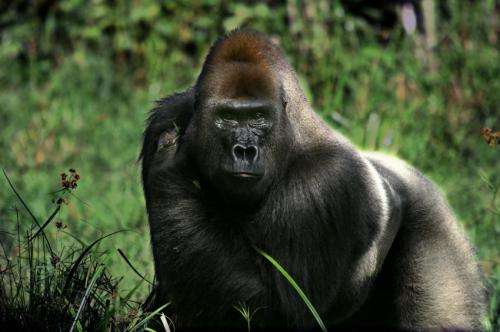Odor communication in wild gorillas

Silverback gorillas appear to use odor as a form of communication to other gorillas, according to a study published July 9, 2014 in the open-access journal PLOS ONE by Michelle Klailova from University of Stirling, UK, and colleagues.
Mammals communicate socially through visual, auditory, and chemical signals. The chemical sense is in fact the oldest sense, shared by all organisms including bacteria, and mounting evidence suggests that humans also participate in social chemical signaling. However, not much is known about this type of signaling in closely related hominoids, like wild apes. To better understand chemical -communication in apes, scientists in this study analyzed odor strength in relation to arousal levels in a wild group of western lowland gorillas in the Central African Republic, specifically focusing on the male silverback, or the mature leader of the group. Scientists determined the factors that predicted extreme levels of odor emission from the silverback. They hypothesized that if gorilla scent were being used as a social signal, instead of only a sign of arousal or stress, odor emission would depend on social context and would vary depending on the gorilla's relationship to other gorillas.
According to the results, the male silverback may use odor as a modifiable form of social communication, where context-specific chemical-signals may moderate the social behaviors of other gorillas. The authors predicted extreme silverback odor, where the odor was the only element that could be smelled in the surrounding air, by the presence and intensity of interactions between different gorilla groups such as silverback anger, distress and long-calling auditory rates, and the absence of close proximity between the silverback and the mother of the youngest infant. The authors suggest that odor communication between apes may be especially useful in Central African forests, where limited visibility may necessitate increased reliance on other senses.
Michelle Klailova added, "No study has yet investigated the presence and extent to which chemo–communication may moderate behaviour in non-human great apes. We provide crucial ancestral links to human chemo-signaling, bridge the gap between Old World monkey and human chemo-communication, and offer compelling evidence that olfactory communication in hominoids is much more important than traditionally thought."
More information: Klailova M, Lee PC (2014) Wild Western Lowland Gorillas Signal Selectively Using Odor. PLoS ONE 9(7): e99554. DOI: 10.1371/journal.pone.0099554
Journal information: PLoS ONE
Provided by Public Library of Science
















